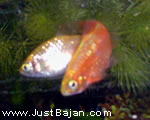| Avg.
Price: $4 - $6 (BD$) Species/genus:
Barbus Conchonius Common Name(s): Rosy
Barb, Rosey Barb Origin: India, Assam &
Bengal Water Conditions: pH:
6 to 7; Temp: 64°- 72°F (18 -22°C) Hardness: Soft Water Temperament:
Very active & non-aggressive in groups. They may chase fish and nip the
fins of other fish when kept in small numbers. It is best to keep at least 6 since
they are shoaling fish. They tend to stick together as a group, are less nervous,
and wouldn't bother the other fish. Adult Size:
2-3 inches. Up to 6 inches in the wild. Water
Region: Bottom, Middle & Upper regions of the aquarium. Rosy
Barbs eating spinach
 Feeding:
Omnivorous. Will readily accept all types of live & prepared foods. Can be
fed flakes, spirulina, lettuce, spinach, brine shrimp, freeze dried foods, mosquito
larvae etc. Rosy Barbs eat very fast, so make sure your other fish get somthing
to eat. They will often nip at plants. To keep Rosy Barbs from eating your plants,
try feeding them spinach (soften the spinach in hot water). They will usually
ignore the other plants and go for the spinach. Sexual
Differences: Adults Easily distinguished. When in good condition, males
are a rosy pinkish red, with black tipped fins. Females have a yellowish to silver
body. Females are also rounder especially when they have eggs. Females have lighter
coloured fins. Courtship. Male on Right
 Breeding: Type: Egg
layer. Difficulty: Easy. Rosy Barbs will breed in your aquarium without
much persuasion, but unless the tank is properly prepared, the eggs will be eaten.
Rosy Barbs will eat they own eggs before they even get a chance to sink to the
bottom. Even if the eggs hatch, the fry will quickly become the lunch of their
parents and other fish. A separate breeding tank or container should be prepared.
A sponge filter should be used (power filers suck up babies). The water level
in the tank should be shallow, about 6 to 8 inches high, and the lighting low
to moderate. The water should be a combination of tap and rain water. Try to maintain
a pH around 6.7 & 6.8. Cover the bottom of the tank with course gravel or marbles
so that the eggs can slip between the crevasses out of reach of the parents. Barbs
like to breed among plants. Add lots of plant to the tank, especially floating
ones (this also helps to subdue the light). Keep the males and females separate
and condition them with high quality foods. Choose a female that is plump and
bursting with eggs and 2 richly coloured males (2 males to one female increases
their chances of fertilizing more eggs). Add them to the breeding tank when it's
getting dark. This helps them to settle in before they do the do in the morning
or the day after. After the female has dropped all her eggs (she should look much
slimmer) remove the parents, or else they will feast on caviar. The fry hatch
in 24 to 48 hours. The fry are very small and should be fed infusoria (micro organisms)
when they start to swim. After a week the can be fed freshly hatched brine, then
larger foods as they grow. If you don't know how to culture your own infusoria
or brine shrimp, ask at your pet store for specially prepared foods for the fry
of egg layers. Minimum Tank Size: 5 gallons Tankmates:
Other Barbs, paradise fish, danios such as zebra danios, tetras & small to
medium sized cichlids. Since rosy barbs are active, they make good "dither fish"
for shy cichlids. The shy cichlids may come out of hiding when they see other
fish swimming around in the open. Since the rosy barbs are fast swimmers, if the
cichlids attack them, they stand a good chance of getting away. Special
Requirements: Best kept in groups of 6 or more or they will be very
nervous and aggressive. Comments: The Rosy
Barb is a very hardy fish and a good choice for beginners. They are very active
and a delight to watch. They are very easy to feed as they will accept almost
anything you put into the tank. | 


